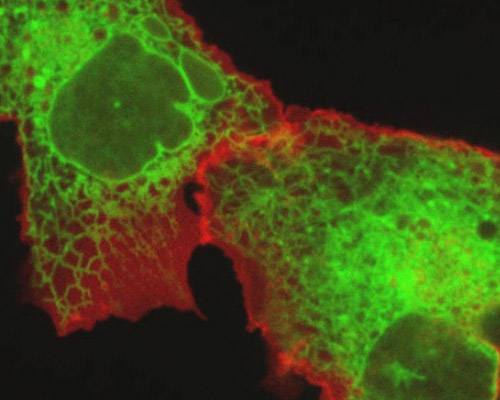Monkey Kidney Cells with mEmerald-ER and mCherry-CAAX

African green monkey kidney fibroblast cells (CV-1 line) are often used in transfection experiments and are realized to be susceptible to a variety of viruses, including simian virus 40 (SV40). The CV-1 fibroblast line was first used in research focusing on the transformation of the Rous sarcoma virus (RSV), a cancer-causing virus, but is now a popular host for AIDS research in addition to SV40 experiments. The CV-1 cells appearing in this digital video sequence are visualized expressing mEmerald fused to the endoplasmic reticulum and mCherry fused to farnesyl groups.
The addition of a 15 carbon farnesyl group or a 20 carbon geranylgeranyl group to the C terminal of a protein is the hallmark of the post-translational protein modification known as isoprenylation. An increase in the hydrophobic characteristics of proteins and an increase in the number of membrane interactions that occur are often associated with protein isoprenylation.
The green fluorescent protein employed to visualize the endoplasmic reticulum, mEmerald, is a monomeric variant of EGFP, an enhanced Aequorea derivative. mEmerald experiences peak excitation at 487 nanometers and peak emission at 509 nanometers. The red fluorescent protein mCherry (labeling farnesyl) is one of the mFruit fluorescent proteins developed by Roger Tsien and colleagues. Excitation and emission of mCherry peak at 587 and 610 nanometers, respectively.



